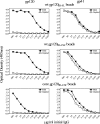Dissecting the neutralizing antibody specificities of broadly neutralizing sera from human immunodeficiency virus type 1-infected donors
- PMID: 17409160
- PMCID: PMC1900098
- DOI: 10.1128/JVI.02749-06
Dissecting the neutralizing antibody specificities of broadly neutralizing sera from human immunodeficiency virus type 1-infected donors
Abstract
Attempts to elicit broadly neutralizing antibody responses by human immunodeficiency virus type 1 (HIV-1) vaccine antigens have been met with limited success. To better understand the requirements for cross-neutralization of HIV-1, we have characterized the neutralizing antibody specificities present in the sera of three asymptomatic individuals exhibiting broad neutralization. Two individuals were infected with clade B viruses and the third with a clade A virus. The broadly neutralizing activity could be exclusively assigned to the protein A-reactive immunoglobulin G (IgG) fraction of all three donor sera. Neutralization inhibition assays performed with a panel of linear peptides corresponding to the third hypervariable (V3) loop of gp120 failed to inhibit serum neutralization of a panel of HIV-1 viruses. The sera also failed to neutralize chimeric simian immunodeficiency virus (SIV) and HIV-2 viruses displaying highly conserved gp41-neutralizing epitopes, suggesting that antibodies directed against these epitopes likely do not account for the broad neutralizing activity observed. Polyclonal IgG was fractionated on recombinant monomeric clade B gp120, and the neutralization capacities of the gp120-depleted samples were compared to that of the original polyclonal IgG. We found that the gp120-binding antibody population mediated neutralization of some isolates, but not all. Overall, the data suggest that broad neutralization results from more than one specificity in the sera but that the number of these specificities is likely small. The most likely epitope recognized by the monomeric gp120 binding neutralizing fraction is the CD4 binding site, although other epitopes, such as the glycan shield, cannot be excluded.
Figures








References
-
- Baba, T. W., V. Liska, R. Hofmann-Lehmann, J. Vlasak, W. Xu, S. Ayehunie, L. A. Cavacini, M. R. Posner, H. Katinger, G. Stiegler, B. J. Bernacky, T. A. Rizvi, R. Schmidt, L. R. Hill, M. E. Keeling, Y. Lu, J. E. Wright, T. C. Chou, and R. M. Ruprecht. 2000. Human neutralizing monoclonal antibodies of the IgG1 subtype protect against mucosal simian-human immunodeficiency virus infection. Nat. Med. 6:200-206. - PubMed
-
- Barbas, C. F., III, T. A. Collet, W. Amberg, P. Roben, J. M. Binley, D. Hoekstra, D. Cababa, T. M. Jones, R. A. Williamson, G. R. Pilkington, et al. 1993. Molecular profile of an antibody response to HIV-1 as probed by combinatorial libraries. J. Mol. Biol. 230:812-823. - PubMed
-
- Beddows, S., S. Lister, R. Cheingsong, C. Bruck, and J. Weber. 1999. Comparison of the antibody repertoire generated in healthy volunteers following immunization with a monomeric recombinant gp120 construct derived from a CCR5/CXCR4-using human immunodeficiency virus type 1 isolate with sera from naturally infected individuals. J. Virol. 73:1740-1745. - PMC - PubMed
-
- Beddows, S., N. Schulke, M. Kirschner, K. Barnes, M. Franti, E. Michael, T. Ketas, R. W. Sanders, P. J. Maddon, W. C. Olson, and J. P. Moore. 2005. Evaluating the immunogenicity of a disulfide-stabilized, cleaved, trimeric form of the envelope glycoprotein complex of human immunodeficiency virus type 1. J. Virol. 79:8812-8827. - PMC - PubMed
Publication types
MeSH terms
Substances
Grants and funding
LinkOut - more resources
Full Text Sources
Other Literature Sources
Medical
Research Materials
Miscellaneous

